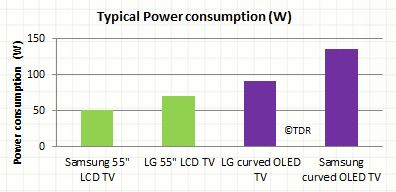Higher Power Requirements in OLED As Compared to LCD TVs
Santa Clara, August 21, 2013—In the recently published “Touch and Emerging Display Monthly Report”, Touch Display Research Inc., an independent market research and consulting firm specializing in touch screen and emerging display technologies, analyzed the worldwide AMOLED and investment situation. Our recent conclusion is that OLED TVs consume more power than LCD TVs of the same size and resolution.
Figure. 55” OLED TV and 55″ LCD TV power consumption
Source: Touch Display Research, Touch and Emerging Display Monthly Report, August 2013
This year, LG Electronics has commercialized both flat and curved versions of its 55-inch OLED TV. Samsung also brought their 55” curved OLED TVs to market in August this year. Samsung’s OLED TV is more than double the power consumption of their 55” FHD LCD. LG’s 55” OLED is also higher power consumption than their same size of LCDs.
As we know, the power consumption of an OLED varies with the content shown on the display. If the content has mostly black images, the majority of pixels don’t need to be activated and thus power consumption is low. When displaying content that is white, the power consumption is higher. Samsung reported a max power consumption of 300W when all the pixels are turned on––more than double the typical power consumption of 135W. Nevertheless, Samsung has indicated that their 55” OLED TV is Energy Star 6.0 compliant.
“OLED displays offer the benefits of curved unique form factors, fast response time, ultimate contrast ratio, and full color. AMOLED is a mature technology for small-sized displays and has been in mass production for a decade. However, OLED TVs still have room to improve. OLED TV shipments will continue to be small in 2013 and 2014.” said Dr. Jennifer Colegrove, president and analyst of Touch Display Research Inc.
Touch Display Research forecasts 4K OLED TV will enter the market by 2015.
Touch Display Research forecasts that 2016 will be the takeoff year for OLED TVs. By 2020 the OLED TV market will reach $15.5 billion.
- Six ways to reduce OLED TV’s power consumption
- Novaled’s new owner and future
- China OLED manufacture roadmap
- 4K TV supply chain
- Flexible active matrix displays roadmap
- Touch screen trends
“Touch and Emerging Display Monthly Report” has analyzed all these topics and more. Our report provides analysis of touch screens, OLED displays, OLED lighting, e-paper displays, flexible displays, 3D displays, pocket projectors, near-eye display technologies and market trends. It not only covers recent developments but also has comparisons, insights, and market forecasts. The report also reviews conferences and trade shows at which we have attended or given a speech. With one year of this report, we can be your “eyes & ears” with insight on touch screen and emerging display technology for twelve months. The August 2013 report is available in PDF format and can be downloaded immediately. You can subscribe on our website: www.touchdisplayresearch.com in the product and service page, or contact us by email: jc@touchdisplayresearch.com
About Touch Display Research Inc.
Touch Display Research, Inc. is an independent technology market research and consulting firm specializing in touch screen and emerging display technologies such as OLED displays, OLED lighting, flexible displays, e-paper displays, 3D displays, near-eye displays, pocket projectors, quantum dots, gesture controls, voice controls, and eye controls. Touch Display Research provides standard reports, consulting projects, and due diligence for touch suppliers, display manufacturers, consumer electronics ODMs/OEMs, material suppliers, investor companies, venture capitalists, and companies who are merging or acquiring companies in the touch screen, display, and materials industry. More about us on our website: TouchDisplayResearch.com.

